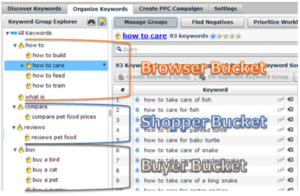Effective Keyword Grouping for Pay-Per Click
One of the most underrated means of driving down your PPC costs and driving up the number of conversions you can generate through paid search is effectively grouping and segmenting your keywords.
In this article I’ll cover one means of effectively grouping keywords for pay-per click marketing: keyword grouping by purchase intent.
The aim in improving your keyword organization – via keyword grouping by purchase intent or any other means – is to help you to increase click-through rates (and subsequently Quality Scores), better manage your paid search budget, and create better focused (and higher converting) paid search landing pages.
Knowing Which Levers to Pull
As you set out to structure your keywords, you need to be cognizant of the different “organizational levers” available to you, and when to pull which:
- Campaigns – Your campaign is basically a shell that helps you to manage different Ad Groups. The controls available to you at the campaign level are:
- Locations
- Languages
- Network
- Bidding
- Ad Rotation
- Ad Scheduling
- Ad Groups – Your Ad Group allows you to match a list of keywords to a series of ad text variations
If you have specific location or language requirements, it may make sense to take a geo-focused approach to campaign creation. Similarly, if you are applying ad rotation or scheduling and/or network and bidding strategies in non-traditional ways that will “trump” any of the following organizational tactics. The nice thing about the following grouping strategies is that they can all be executed within a campaign; in other words, once you’ve settled on a campaign structure, you can then organize your keywords within that campaign by Ad Group using any of the following methods.
Grouping Keywords By Purchase Intent
Basically, the idea behind grouping keywords by purchase intent is to create a campaign and Ad Group structure that maps closely to the way people actually research and purchase products. You can do this by segmenting your keywords by modifiers.
Modifiers are basically adjectives that are appended to a core keyword and reveal an additional layer of intent. Some great examples of modifiers that reveal purchase intent are:
- How-to – This is an informational modifier; people searching for “how to” do things are typically either just looking for information, or are very early in the buying cycle. These searchers are still “browsers” looking to learn more about their potential purchase.
- Compare – People looking to compare products are also on the lookout for information, but these fit more closely to the “shop” stage of the buying cycle; by asking for a comparison of different products the searcher is revealing that they’ve narrowed their choices and would like to learn a bit more about two products.
- Buy – This is clearly a transactional modifier, and the searcher is obviously ready to purchase something: they’re in the “buy” stage of the buying cycle.
You can then use these modifiers and others like them to create a high level keyword hierarchy:
The above image is our software, but you could easily use Excel to create this architecture for your paid campaign. You’ll work through the keyword organization a bit like this:
- Purchase Stage – This is the initial container you’ll use to house different modifiers (browse, shop, or buy).
- Modifiers – Here you can create a segmentation around a specific modifier: for instance how-to, what is, etc.
- Semantically grouped sub-segmentations – Once you have a “how-to” bucket, it’s not enough to just throw all of your keywords into a campaign or ad group based solely on the fact that they share a modifier. You then have to dig even deeper to create more specific segmentations within your modifier groups, like “buy a bird” versus “buy a cat” pictured above.
So What Does All this Allow You to Do?
By organizing your keywords based on purchase intent, you’ll now have campaigns and Ad Groups that map neatly to buyer intent. This improves your ability to:
- Measure performance based on the stage of the query – Look at cost and conversion data based on each stage in the buying cycle. You’ll get some particularly interesting data by investigating newly released AdWords search funnel data to see how people are interacting with your ads at every stage of the buying cycle.
- Message to each stage with specific ad copy – By creating really granular segmentations based on buyer intent, you can write very specific ads that speak to searchers. This means increased click-through rates, improved Quality Scores, and lowered costs per click.
- Design a unique landing page experience for each type of searcher – Similarly, you can create landing pages and landing page experiences that speak directly to the searcher. Customize offers, page length, and messaging on your landing pages to answer specific objections, speak to specific pain points, and deliver custom benefit statements
Of course, this is just one means of segmenting keywords: what approach do you take to organizing your keywords for PPC?
About the Author
Tom Demers is the Director of Marketing at WordStream, a provider of pay per click software, The Free Keyword Tool, and advanced PPC tools for researching, organizing and grouping large numbers of keywords for greater PPC campaign relevance and higher Quality Scores.





